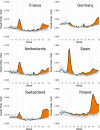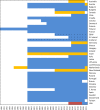The short-term mortality fluctuation data series, monitoring mortality shocks across time and space
- PMID: 34489477
- PMCID: PMC8421508
- DOI: 10.1038/s41597-021-01019-1
The short-term mortality fluctuation data series, monitoring mortality shocks across time and space
Abstract
The COVID-19 pandemic has revealed substantial coverage and quality gaps in existing international and national statistical monitoring systems. It is striking that obtaining timely, accurate, and comparable across countries data in order to adequately respond to unexpected epidemiological threats is very challenging. The most robust and reliable approach to quantify the mortality burden due to short-term risk factors is based on estimating weekly excess deaths. This approach is more reliable than monitoring deaths with COVID-19 diagnosis or calculating incidence or fatality rates affected by numerous problems such as testing coverage and comparability of diagnostic approaches. In response to the emerging data challenges, a new data resource on weekly mortality has been established. The Short-term Mortality Fluctuations (STMF, available at www.mortality.org ) data series is the first international database providing open-access harmonized, uniform, and fully documented data on weekly all-cause mortality. The STMF online vizualisation tool provides an opportunity to perform a quick assessment of the excess weekly mortality in one or several countries by means of an interactive graphical interface.
© 2021. The Author(s).
Conflict of interest statement
The authors declare no competing interests.
Figures


References
-
- EUROSTAT. Weekly deaths – special data collection (demomwk). https://ec.europa.eu/eurostat/cache/metadata/en/demomwk_esms.htm (2020).
Publication types
MeSH terms
Grants and funding
LinkOut - more resources
Full Text Sources
Medical

